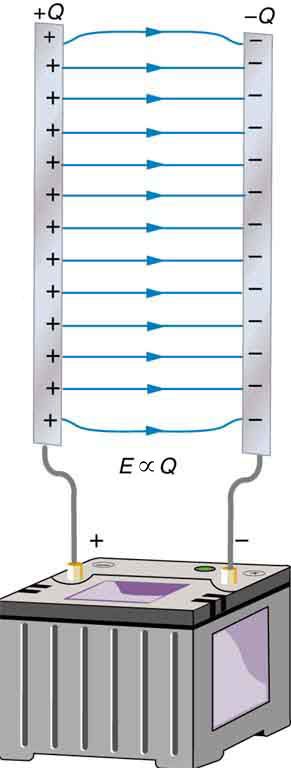2.2 Capacitors
What is a Capacitor?
A capacitor is a crucial electronic device used to store charge and electrical potential energy. Capacitors are widely utilized across various applications, from your cell phone’s camera flash to advanced electronic circuits in industrial equipment. While capacitors come in many shapes and designs, the parallel-plate capacitor is one of the most fundamental and commonly studied types.


How Does a Parallel-Plate Capacitor Work?
A parallel-plate capacitor consists of two conductive plates separated by a small distance. A dielectric material is often added between these plates to enhance the capacitor’s charge-storing capability. When a battery or voltage source is connected, charges accumulate on the plates, creating an electric field in the gap between them.
Key Components:
Conductive Plates: These are the regions where charge is stored.
Separation Distance: The distance between the plates determines the capacitance.
Dielectric Material: An insulating material that increases the amount of charge the capacitor can store.
Theory Behind a Parallel-Plate Capacitor
When the plates of a capacitor are connected to a voltage source, charges accumulate, creating an electric field. The strength of this field is directly proportional to the amount of charge stored and inversely proportional to the distance between the plates. The voltage between the plates is related to the electric field as:
From this, we can derive the capacitance of the capacitor, which is the constant of proportionality between and:
The unit of capacitance is the Farad (F), where:

Physical Factors Affecting Capacitance:
Plate Area: Larger plates store more charge, increasing capacitance.
Distance: Smaller separation distances result in stronger electric fields and higher capacitance.
Dielectric Constant (κ): Adding a dielectric material increases capacitance by reducing the electric field strength.
For a parallel-plate capacitor with air as the dielectric, the capacitance is given by:
where:
is the permittivity of free space.
is the area of one plate.
is the distance between the plates.
Exploring Different Types of Capacitors
While parallel-plate capacitors are foundational, there are several other geometrical configurations you may encounter:
1. Spherical Capacitors:
These consist of two concentric spherical conductors. The capacitance is derived using: where and are the radii of the inner and outer spheres, respectively.

2. Cylindrical Capacitors:
These capacitors use two coaxial cylindrical conductors. The capacitance is calculated using: where is the length of the cylinder, and and are the radii of the inner and outer cylinders, respectively.

These variations illustrate how capacitor design adapts to specific applications while maintaining the same basic principles.
Energy Storage in Capacitors
Capacitors store energy in the form of an electric field. The potential energy stored in a capacitor is given by:
This formula shows that the energy stored depends on both the capacitance and the voltage applied. Capacitors are widely used in circuits for:
Energy Storage: Short-term energy bursts in devices like camera flashes.
Voltage Regulation: Smoothing out fluctuations in power supply.
Signal Processing: Filtering and tuning signals in communication systems.
Practice Problems for Mastery
Example 1:
Problem: A 20 µF parallel-plate capacitor is charged to 20 V. Calculate the energy stored in the capacitor.
Solution: The energy stored is 0.004 J.
Example 2:
Problem: A capacitor with circular plates of radius and separation has a capacitance . If the plate radius is doubled and the separation is halved, what is the new capacitance in terms of ?
Solution:
Since , doubling quadruples , and halving doubles:
Summing It Up
Capacitors are indispensable components in electronics, enabling energy storage, signal processing, and power regulation. Understanding the principles of capacitance and energy storage empowers engineers and students to design efficient circuits and devices. Use the practice problems and derivations to deepen your mastery of this critical topic, and stay tuned for our next section on dielectrics to learn how materials between capacitor plates enhance their performance.







